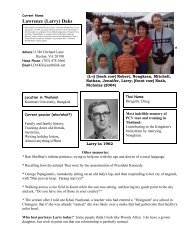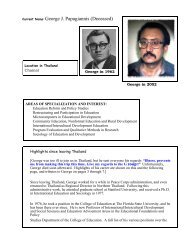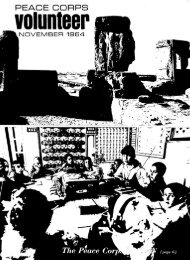PEACE CORPS
Peace Corps Volunteer â January 1966 - Peace Corps Online
Peace Corps Volunteer â January 1966 - Peace Corps Online
- No tags were found...
You also want an ePaper? Increase the reach of your titles
YUMPU automatically turns print PDFs into web optimized ePapers that Google loves.
PCVS spur development<br />
The Cornell Peru Report concludes<br />
that community development proceeds<br />
at a much f=ter pace when a Peace<br />
Corps Volunteer is on the scene.<br />
The research team carefully aria.<br />
Iyzed everything Volunteers did in 15<br />
communities. It also traced the rate of<br />
development in five villages where the<br />
Peace Corps wasn’t,<br />
The Peace Corps communities developed<br />
2.8 times faster than the<br />
settlements where there were no<br />
Volunteers,<br />
The rate of development was mess.<br />
ured on a 100-point scale of social<br />
structure, which permitted direct tom.<br />
parison of the relative degree of socioeconomic<br />
differentiation in Peruvian<br />
settlements.<br />
The indices on the scale, listed<br />
below, were selected so as to put only<br />
Lima, the largest city in Pew and the<br />
central city for commerce, finance, industry,<br />
communications, arts and sciences,<br />
and government, at 100 points,<br />
The indices range from garbage dis.<br />
posal to daily newspaper, cemetery to<br />
swimming pool, barber to university<br />
graduate. Each rates a point on the<br />
scale. In the Peruvian bigblan~, prosress<br />
comes in small doses. One town,<br />
for example, gained a point with the<br />
acquisition of a portable water installation<br />
inspired by two Volunteers, An.<br />
other village picked up a point when<br />
four trucks were purchased,<br />
Before 1962, the village of Cbijnaya<br />
had no score whakoever. It was zero<br />
on the social structure scale; By 1965,<br />
it bad a score of 21, largely through<br />
the efforts of tbe Peace Corps (see<br />
Page 18),<br />
The researched gave some attention<br />
to Volunteer impact in the complex<br />
urban settlements of Puno, Cuzco, and<br />
Huaraz. In the social scale ratings, no<br />
increases were measured in those cities,<br />
though the researchers found that Vol.<br />
unteers substantially reinforced many<br />
existing institutions.<br />
In eliminating these three’ cities<br />
from the 15 smple settlement studied<br />
by Cornell, ti’e research team found<br />
that the rate of scale increase for tbe<br />
remaining 12 rural communiti~ was<br />
2.1 points per community per year.<br />
That is 3.47 times faster than the<br />
rate atablished for the five compari.<br />
son community samples, which were<br />
similar to the 12 villages except that<br />
they did not have Peace Corps Volun.<br />
teers. The basic rate of scale increase<br />
for the five rural settlements without<br />
Volunteers was .6 point per community<br />
per year.<br />
“Future studies of the settlements<br />
where Volunteem worked during the<br />
1962-64 period will be required to<br />
discover whether these communities<br />
continue to increase in scale of social<br />
structure more rapidly than Andean<br />
settlements which have not received<br />
the stimulus of Volunteer action,” the<br />
report says,<br />
“What we are able to say, on the<br />
basis of the first two years’ record,<br />
is that Volunteen clearly fostered a<br />
trend toward relatively rapid community<br />
development.”<br />
THE<br />
SCALE<br />
GOVERNMENTALSTRUCTURE<br />
L National Capital: seat of Congress,<br />
chief executive, and principal na.<br />
tional appellate co”fi.<br />
2. Department CaDital: seat of a ore.<br />
feit, analogue of a state in Me~ico<br />
or the United States,<br />
3. Provincial Capital: seat of a sub.<br />
prefect, analogue of a counti in<br />
the United States,<br />
4, District Capital: seat of a registrar<br />
of vital statistics and the smallest<br />
official unit of national govern.<br />
ment, The a[calde (principal administrative<br />
officer) may or may<br />
not reside in the district capital.<br />
5. police protection, defined as hav.<br />
ing a resident policeman of the<br />
Guardia Civil, the national mili.<br />
tarized police force.<br />
6. Government bui Idings other than<br />
those specified in other categories<br />
(e.g., community headquarters, cuv<br />
toms sheds, militav or naval<br />
barracks).<br />
7. Public Charitv Societv (Sociedad<br />
de Beneflcen>ia P“biicil: a pub.<br />
Iic assistance and welfare agency<br />
endowed with land, often manors<br />
with setis bound to them.<br />
8. Community land ownership: parks,<br />
central square, streets, commons,<br />
etc.<br />
9. Municipal police force: independ.<br />
ent of national police,<br />
EDUCATIONALSTRUCTURE<br />
10.<br />
11.<br />
12.<br />
13.<br />
14.<br />
15.<br />
16,<br />
17.<br />
18.<br />
Graduate level university instruction.<br />
university level instruction, incl”dlng<br />
normal schools,<br />
Secondary level instmction, defined<br />
here as complete (e.g., five<br />
vea rs).<br />
Primary level instruction, defined<br />
here as five grades.<br />
Literates: one or more literate residents<br />
(percentage if known),<br />
PrimaV school graduates: one or<br />
more such residents (percentage if<br />
known).<br />
Secondary school graduates: one<br />
or more such residents (percentage<br />
if known).<br />
University graduates: o“e or more<br />
such residents (percentage if<br />
known).<br />
Agricultural extension services,<br />
RELIGIOUS STRUCTURE<br />
19.<br />
20.<br />
21.<br />
22.<br />
23.<br />
24,<br />
Seat of archbishop or cardinal.<br />
Diocesan Seat with cathedral<br />
resident b!shop,<br />
and<br />
Parish headquatiers with resident<br />
parish priest,<br />
Church or chapel building.<br />
Protestant chapel and congregation.<br />
Religious lay voluntaw associations<br />
that are permanent and formally<br />
organized, other than congregations.<br />
8<br />
BASIC COMMUNITYSERVICES<br />
25.<br />
26.<br />
27.<br />
2a.<br />
29.<br />
30.<br />
31,<br />
32.<br />
33.<br />
34.<br />
35.<br />
36.<br />
37. -.<br />
3a.<br />
39.<br />
EiectriciM electric power plant,<br />
public lighting, household semice.<br />
Market: public marketing area,<br />
supewised and housed in public<br />
building.<br />
Water SUDDIY DiDed into Dublic<br />
taps andlor “houses.<br />
Canal irrigation works.<br />
Public square: improved (e.g., con-<br />
Crete walks,<br />
tains, etc.).<br />
trees, shrubs, fo””.<br />
Paved or cobbled streets.<br />
Garbage collection and disposal.<br />
Swimming pool.<br />
Public school pupil. feeding pro.<br />
gram.<br />
Welfare program (such as Gritas).<br />
Intra-city bus, cokctivo, taxi semice.<br />
Sports field.<br />
Cemetery.<br />
hblic Iibraw. sectarian or Drivate.<br />
Museum: public or private (number<br />
per 1,000 population if known).<br />
COMMUNICATIONS<br />
40,<br />
41.<br />
42,<br />
43.<br />
44,<br />
45.<br />
46.<br />
47.<br />
Airpoti and regular ftights.<br />
Railway,<br />
Highway: a vehicular road<br />
passable.<br />
Post office.<br />
Telegraphic semice.<br />
that<br />
Telephonic sewice.<br />
Interprovincial tramp truck service<br />
and scheduled truckers.<br />
Interprovincial bus sewice.<br />
is













